
Shuib Abdullah
Whether you’re selling a product or a service, the end goal is one thing. Sales. There are so many different website building platforms available, and they all have their own perks, drawbacks and special features. Two of the most common are either a Webflow or ClickFunnels based approach to website building. Although they are two very different options, both are packed with user-friendly features. So let’s take a walk through the two to get better acquainted!
Webflow vs ClickFunnels: Main differences
- Webflow allows more advanced customizations without the need for custom code, whereas ClickFunnel is quite simple
- Webflow doesn’t have a wide range of marketing tools built in, whereas ClickFunnels has some great marketing tools like abandoned cart recovery
- Webflow has a powerful & versatile CMS, whereas ClickFunnels isn’t suited for content-driven sites
- Webflow allows developers to build custom animations without code, whereas ClickFunnels doesn’t
- ClickFunnels includes affiliate marketing tools out of the box, whereas Webflow requires a third-party integration
- Webflow offers 5 plans with a free plan, whereas ClickFunnels offer a 14-day trial and 2 paid plans
What is Webflow?
Webflow is a comprehensive website design and development platform that combines visual design tools with powerful content management capabilities. It allows users to create responsive websites without writing code, using a visual editor that generates clean, semantic HTML, CSS, and JavaScript. Webflow offers advanced features such as custom animations, interactions, and a built-in content management system (CMS) for dynamic content. While it provides a no-code interface for design and layout, Webflow also allows for custom code integration, making it suitable for both beginners and experienced web developers. Webflow is ideal for content-driven sites and also eCommerce thanks in part to the integration of third-party tools like Shopify & Calendly being fairly straightforward.
What is ClickFunnels?
ClickFunnels is a specialized marketing platform designed to create sales funnels and landing pages quickly and easily. It offers a drag-and-drop interface with pre-built templates and elements focused on converting visitors into leads or customers. ClickFunnels includes features like A/B testing, email integration, and payment processing, all geared towards optimizing the sales process. While primarily aimed at marketers and entrepreneurs, ClickFunnels can be used to create simple websites, though its main strength lies in building conversion-oriented sales funnels.
Webflow vs ClickFunnels: Design & Development
Webflow & Clickfunnels each allow you to create beautiful, brand-focused websites with various features to boost conversion/sales. While Webflow empowers users with a blank canvas and precise control over every pixel, ClickFunnels hands them a toolbox of pre-optimized elements, with each approach shaping the design process in fundamentally different ways.
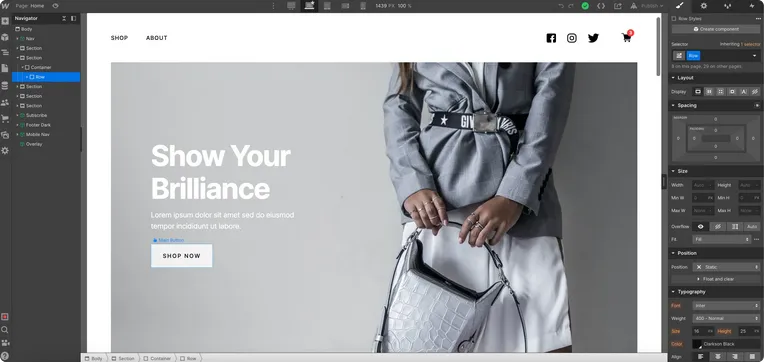
Webflow
Webflow can be used as an advanced or basic page builder depending on your needs and skills. They have a large library of premium and free templates which are vetted by the Webflow team and which can be used to build almost any type of site. Although it can take a while to get used to Webflow’s design tools, the possibilities to create unique multi-page websites are endless. Since Webflow is a low-code platform, anything you can do in CSS is possible with the designer, including a variety of animations and transitions.
However, if you don't have the time to spend designing different sections of your site, you can use a component library like Relume with hundreds of professional web components. Webflow even keeps a master page of all the 35 available template libraries that you can use with their site here. Best of all, 22 out of the 35 libraries are either totally free or have some aspects available at no cost to the user. Webflow has recently updated its designer to include features like running audits on the current page to check and improve your site's performance and usability. Easy things can be missed like missing alt tags or non-descriptive link content, which is crucial for SEO.
Most importantly, Webflow has a large amount of help available through various guides, online tutorials, Live Customer Service Chat and Webflows own “Webflow University” videos which cover a broad range of related topics.
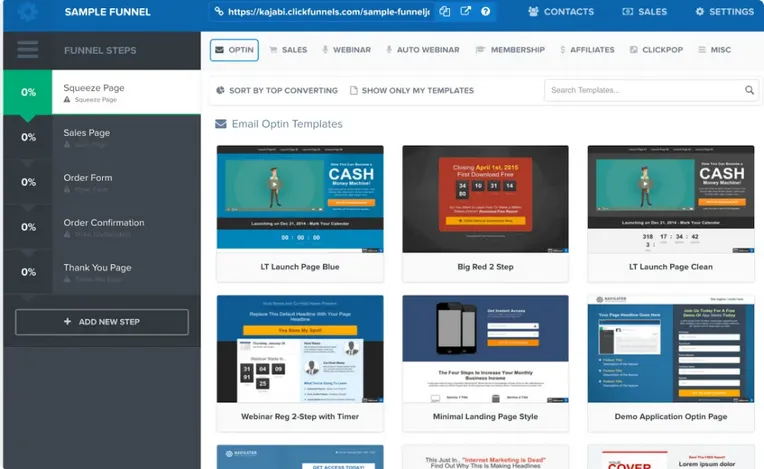
ClickFunnels
ClickFunnels offers a streamlined approach to design, focusing primarily on creating effective sales funnels and landing pages. The platform provides a variety of pre-designed templates, each optimized for specific industries or marketing objectives. These templates serve as starting points, allowing users to quickly set up professional-looking pages without extensive design knowledge. The drag-and-drop editor enables easy customization of these templates, with options to adjust layouts, colors, fonts, and content to match brand aesthetics.
While ClickFunnels prioritizes conversion-oriented design over artistic flexibility, it does offer some room for creativity within its framework. Users can add custom CSS to further personalize their pages, though this feature is limited compared to more design-centric platforms. The design options in ClickFunnels are geared towards creating high-converting funnels rather than complex, unique websites. This approach makes it accessible for marketers and entrepreneurs who need to quickly deploy effective sales pages, but it may feel restrictive for those seeking more advanced design capabilities or unique visual presentations.
Webflow vs ClickFunnels: Features
Webflow
Webflow has a host of features that allows you to build modern, web-friendly and perfomance driven landing pages. The biggest difference in features between Webflow and ClickFunnels is integrations. Webflow developers rely on third-party tools like HubSpot & Vimkit to integrate form submissions and connect a CRM to a Webflow site. In recent years, developers have been spoilt for choice with countless integration tools popping up all over the web. You can read a more comprehensive and in depth article specifically about these types of features here or visit Webflow’s Integrations Library here. This means there's a tool for almost everything you need. If you’re looking for some of the top performing integrations, check out this article: https://www.memberstack.com/blog/best-webflow-integrations
With sale funnels and tracking business metrics, A/B split testing is a staple, luckily this is also possible with Webflow, just not natively. In your Webflow project settings, simply paste in your Google Optimize Customer ID and save your changes. You’ll also need to add your Google Analytics tracking ID. Here's a full guide by Webflow Unversity: https://university.webflow.com/lesson/integrate-google-optimize-for-a-b-and-multivariate-testing
One area in Webflow that really outperforms ClickFunnels is advanced Search Engine Optimization (SEO) control. A lot of systems let you add/edit metadata, create photo alt text, and also target search phrases. Webflow does one action better by using immediately generated sitemaps and also adjustable 301 redirects. This means your site is ready to be crawled by Google and you won't be missing key SEO points when you launch.
For further detail, Webflow keeps a comprehensive list of changes, additions and updates on their website here.
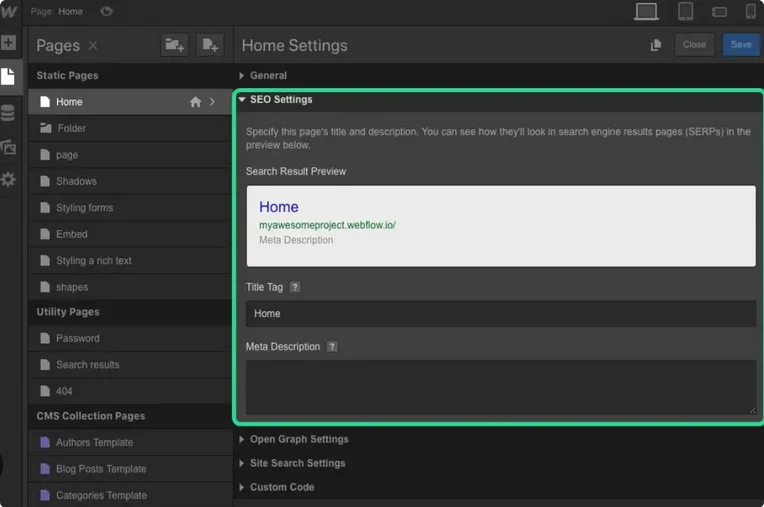
Click funnels
ClickFunnels has many integrated features for creating and testing your funnels. One of the key features here is also A/B split testing, an option that is built into ClickFunnels natively. This method involves a randomized experimental process where two versions of a variable (in this case, a landing page) are shown to different segments of users simultaneously. This is so one can determine which version leaves the maximum impact at increasing business metrics, for example, conversion rates for an online store.
Another feature useful for tracking sales is a new and updated CRM for ClickFunnels 2.0 (Consumer Relationship Manager). Getting new customers is important, but retaining those customers is even more valuable to business growth. A CRM allows you to build relationships with your customers and collect valuable information on an individual contact.
The platform integrates seamlessly with popular email marketing services and payment gateways, facilitating smooth communication with leads and hassle-free e-commerce transactions. ClickFunnels also provides tools for creating and managing membership sites or online courses, making it versatile for different types of digital products and services.
ClickFunnels emphasizes performance tracking with basic analytics and reporting features, helping users understand their funnel performance and user behavior. The platform ensures mobile responsiveness, adapting funnels to various devices and screen sizes. Advanced sales features like one-click upsells, smart shopping carts with order bumps and coupon codes, and automated follow-up funnels for lead nurturing round out ClickFunnels' offering, making it a comprehensive toolkit for online sales optimization. If you’re a small-medium business, accessing your business metrics in the form of charts & tables is important for making reports for your team to analyze. The image below shows a snapshot of how you can do this
For further detail, ClickFunnels keeps a posted list of changes, additions and updates to their program here.

CMS
ClickFunnels isn’t known for its blogging and CMS (content management system) capabilities. Although you can post blogs, other forms of content are not as easily built through a CMS. These features are generally limited compared to dedicated CMS platforms and are designed to support the sales funnel process rather than extensive content publishing or management.
Webflow has a CMS that enables you to publish various types of content on your website. From blogs and projects to a teams section, the options are pretty endless. Every bit of content can be CMS driven which is great if your team consists of editors, designers & developers. Webflow's CMS is a core feature of the platform, offering a robust solution for managing dynamic content. It allows users to create custom content types, define relationships between different types of content, and design dynamic templates that automatically populate with data from the CMS.
Webflow vs ClickFunnels: Collaboration
Webflow
Webflow makes it easy to collaborate on a project together. For instance, if you’re a freelancer/agency, Webflow has a feature which allows you to be a ‘guest’ on client sites which is a phenomenal tool for collaboration. They also have page-branching, which allows multiple designers to work in parallel on different pages of the same project. Team members can then be assigned different roles and permissions, such as Admin, Designer, or Editor. Users can leave comments directly on design elements, making it easy to provide feedback and discuss specific aspects of a project. Webflow maintains a history of changes, allowing team members to review past versions and revert if necessary. You can watch a video here that goes into more detail about collaborative options.
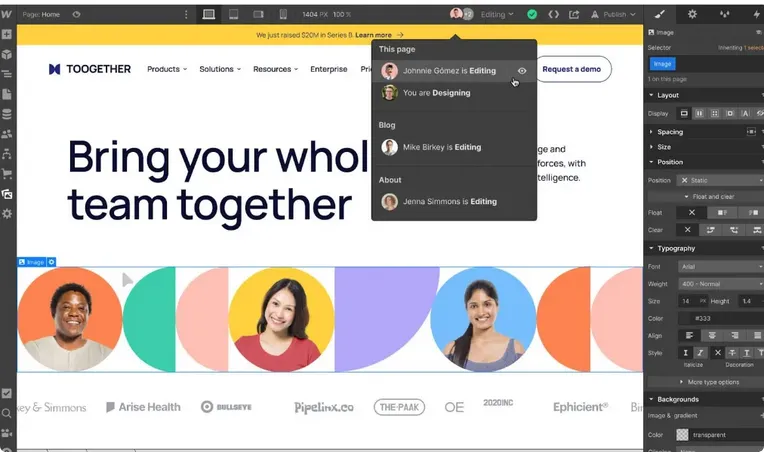
ClickFunnels
ClickFunnels' collaboration features are more limited compared to Webflow, as it's primarily designed for individual entrepreneurs or small marketing teams. Users can share entire funnel templates with team members or other ClickFunnels users, allowing for easy replication of successful funnels. Another notable collaboration feature is user-permissions. You can allow and restrict access to specific aspects of your project based on what each team member needs to do their job. Higher-tier plans allow adding team members to an account, but with limited role differentiation. You can watch a video here that goes into more detail about collaborative options in ClickFunnels.
Clickfunnels 2.0 has a collaboration feature that they call simultaneous editing. You know how in Google Docs several people can edit the same document at the same time? With this feature, you can do the same with the pages in your sales funnel.
Webflow vs ClickFunnels: Ecommerce
Webflow
Let's talk about eCommerce features. Both ClickFunnels and Webflow offer a great eCommerce experience, but both come with a different set of features. For a general overview of Webflow’s eCommerce features from the Webflow University you can visit here. Webflow is well-suited for small to medium-sized online stores with a smaller product range, lower inventories and straightforward e-commerce needs.
If you want to build an online store that is unique and matches your brand, Webflow provides a great developer experience. You can customize every bit of the eCommerce journey including the checkout page. You also don’t have to worry about taxes as it's calculated automatically, meaning you can just focus on designing a great user experience for your customers.
Speaking of user experience, Webflow allows customers to pay with Paypal, Stripe, Google Pay, Microsoft Pay & Apple Pay as well as the major credit card brands of Visa, Mastercard, American Express, Discover, Diners Club, JCB, and UnionPay. Typically, the more payment options customers are presented with, the higher the chance of conversion. Another popular payment option is Buy Now Pay Later (BNPL), and Klarna is at the forefront of this, and just so happens to be easily implemented within Webflow.You can use this in Webflow using Mollie, a tool that works with Foxycart checkout. Read this article for more details: https://wiki.foxycart.com/gateways/mollie
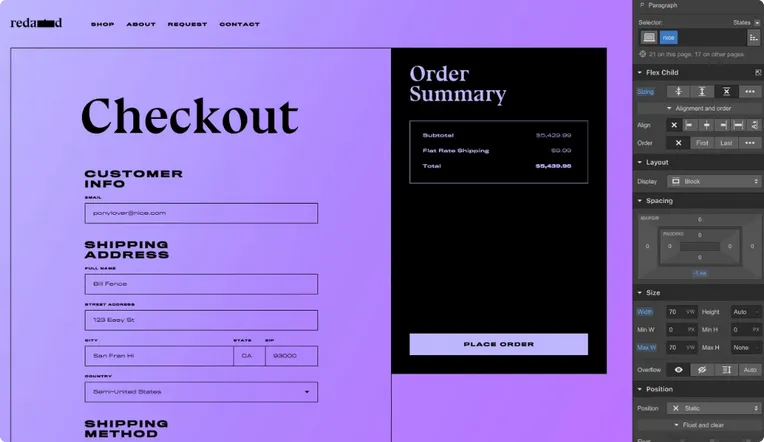
ClickFunnels
The cart provided with ClickFunnels is secure and powerful. The checkout pages are simple to set up,too. Recently, Clickfunnels has updated to be able to use all major credit cards, PayPal, Stripe, Google and Apple Pay (but only if Stripe is your payment gateway).
Furthermore, You can integrate custom checkout flows to set up specific processes to trigger at key points. For instance, sending out an email to a customer when an order is made without having to set this up with a separate email marketing service.
One area ClickFunnels excels in however is their in-built marketing tools, including a one click upsell and order bump feature. Another good example of this is the abandoned cart workflow, which automatically emails customers to remind them to check out. This is also possible with Webflow using the Shopify buy-button integration. To find out more about integrating Shopify with Webflow, check out this article: https://university.webflow.com/integrations/shopify
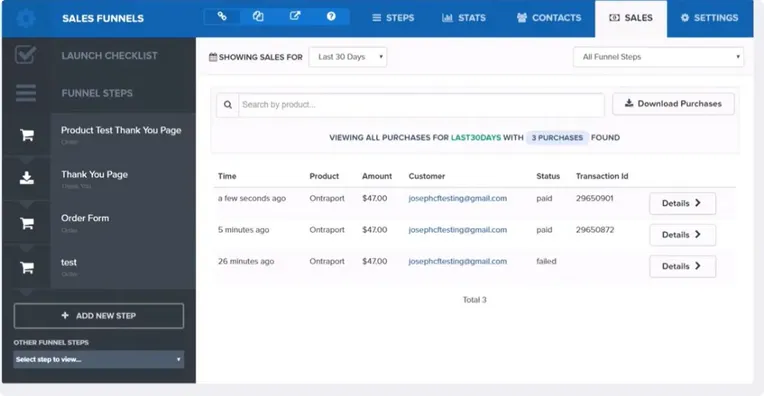
Webflow vs ClickFunnels: Pricing
So how do these platforms compare in terms of pricing?
Webflow
Webflow offers five price plans. There's a free starter plan which is great for those beginning with Webflow, It offers a webflow.io domain, 50 CMS items and up to 50 form submissions. The paid plans start from $14 going to $39 with different levels of features availability in all. The CMS plan is particularly good value as you have 2,000 CMS items, a custom domain and up to 3 guest editors. Find out more on their pricing page here. One of the most creative things Webflow has done however is the “Contact Us” option. If none of the other 4 plans seem like a good fit, most likely because of the large scope and size of your business, then they are willing to work with you to create a customized plan that meets your site’s needs.
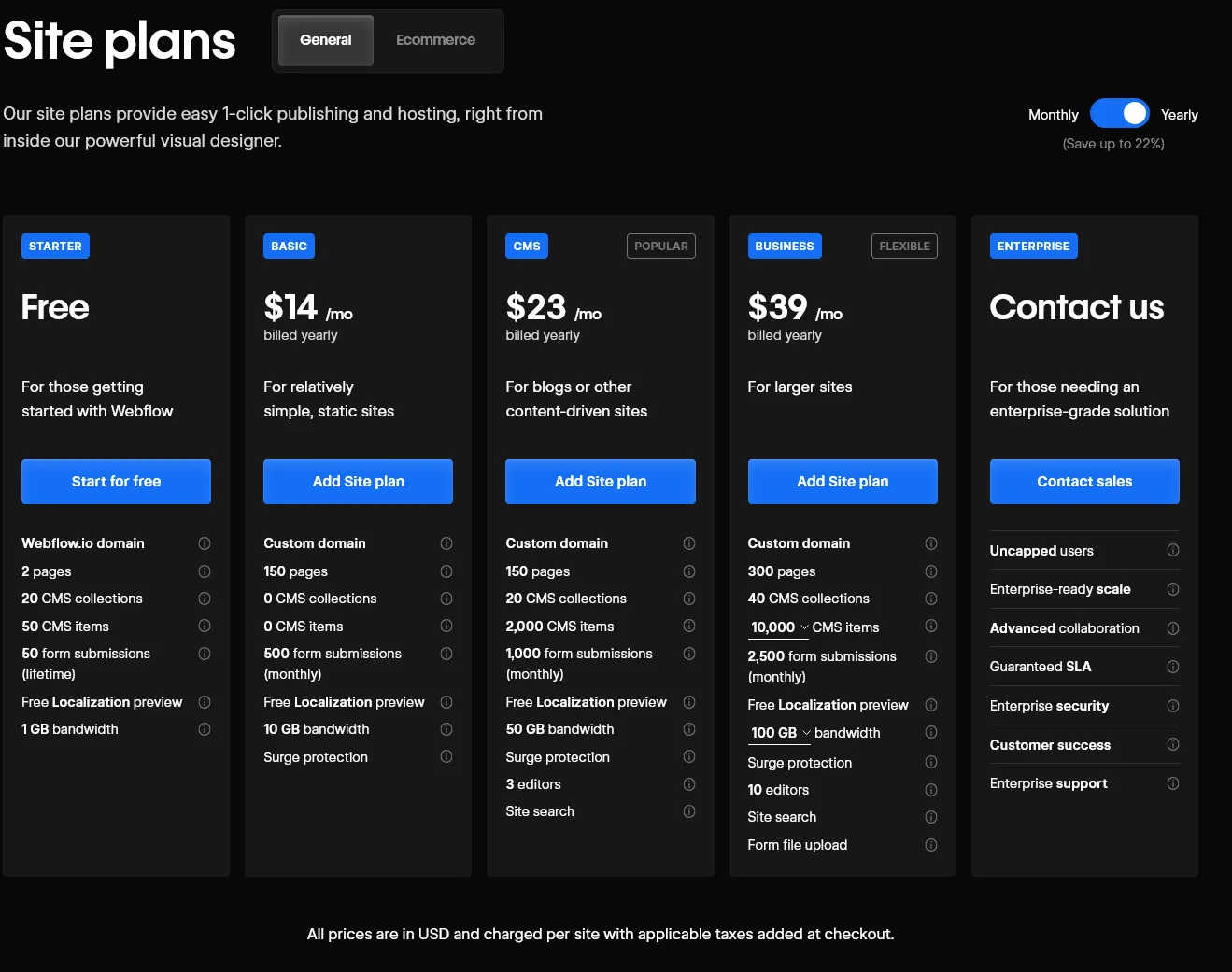
ClickFunnels
ClickFunnels has 3 pricing plans, including a 14-day free trial. Their basic plan is $81/m which includes three brand workspaces and three team members. Their pro plan is $248/m which is suited for medium businesses that would benefit from 10 brand workspaces and team members. Both include unlimited pages, unlimited funnels, unlimited products and more. One important thing to note about ClickFunnels is that even though their price plan is monthly, it is billed annually, therefore you’ll see just one large lump sum charge per year, so you may need to plan accordingly in your budgeting. Clickfunnels does offer a monthly billing option, however it is $16 a month more for the Startup plan and $49 more per month for the Pro plan. Find out more on their pricing page here.
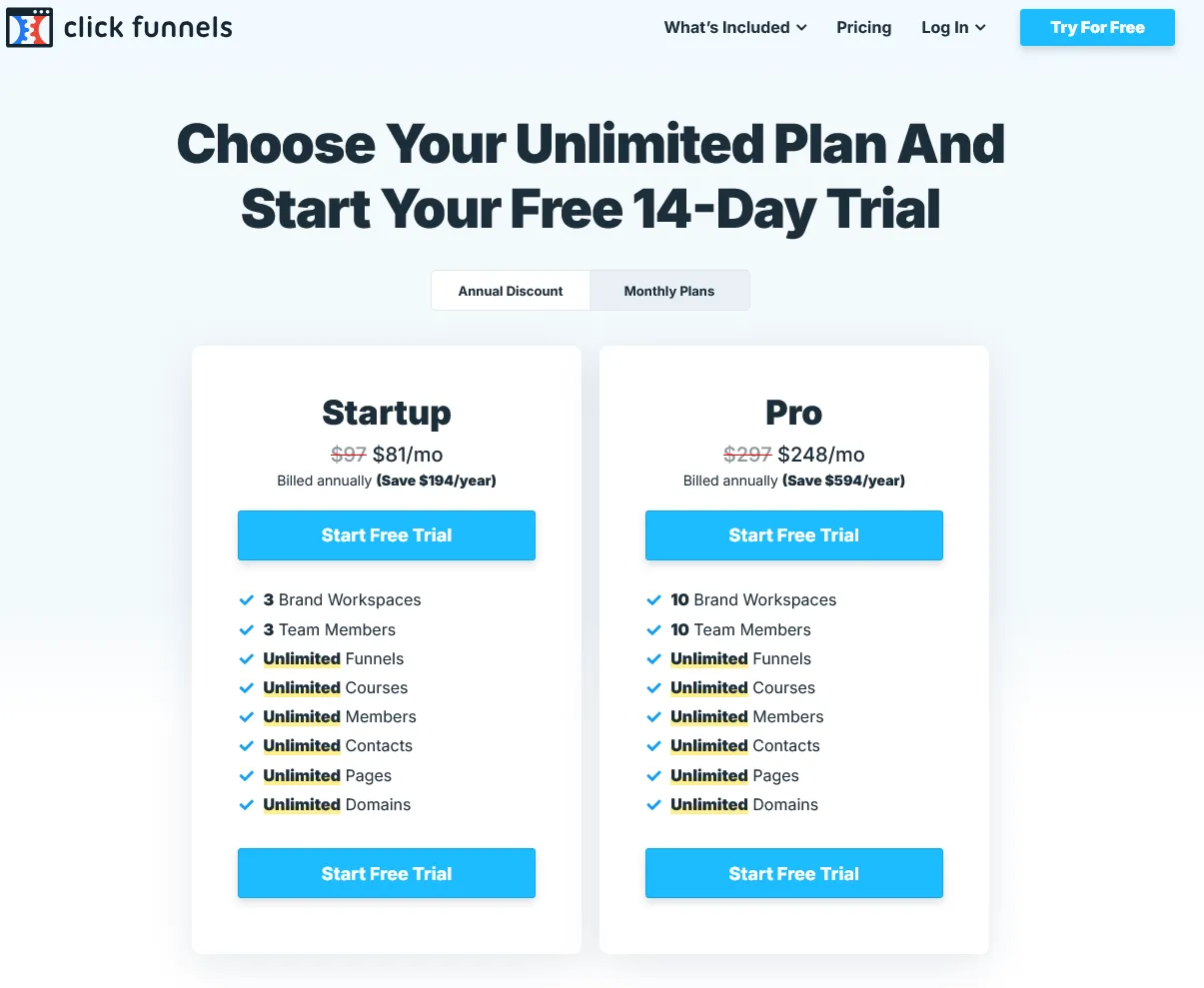
Final thoughts
Webflow and ClickFunnels represent two distinct approaches to website building, each catering to different needs and user profiles. Webflow excels in providing a comprehensive platform for creating visually stunning, responsive websites with powerful CMS capabilities. It is ideal for content-rich sites, portfolios, and complex web applications. Its balance of visual design tools and custom code integration appeals to both designers and developers. ClickFunnels, on the other hand, specializes in rapidly deploying sales funnels and landing pages, with a focus on conversion optimization and marketing automation. Its straightforward, template-driven approach is particularly suited for entrepreneurs and marketers looking to quickly launch and test sales strategies.
The choice between Webflow and ClickFunnels ultimately depends on the specific goals, technical expertise, and long-term vision of the user. Web professionals and businesses seeking design flexibility and scalability may find Webflow more aligned with their needs, while those prioritizing lead generation and sales processes might gravitate towards ClickFunnels. As the web development landscape continues to evolve, both platforms are likely to expand their features and capabilities. Users should carefully consider their project requirements, budget constraints, and growth projections when selecting between these tools. Regardless of the choice, both Webflow and ClickFunnels have demonstrated their value in simplifying the website creation process, contributing to the democratization of web presence for businesses and individuals alike.
Over 200 free cloneable Webflow components. No sign up needed.
Add memberships to your React project in minutes.

.webp)







.png)